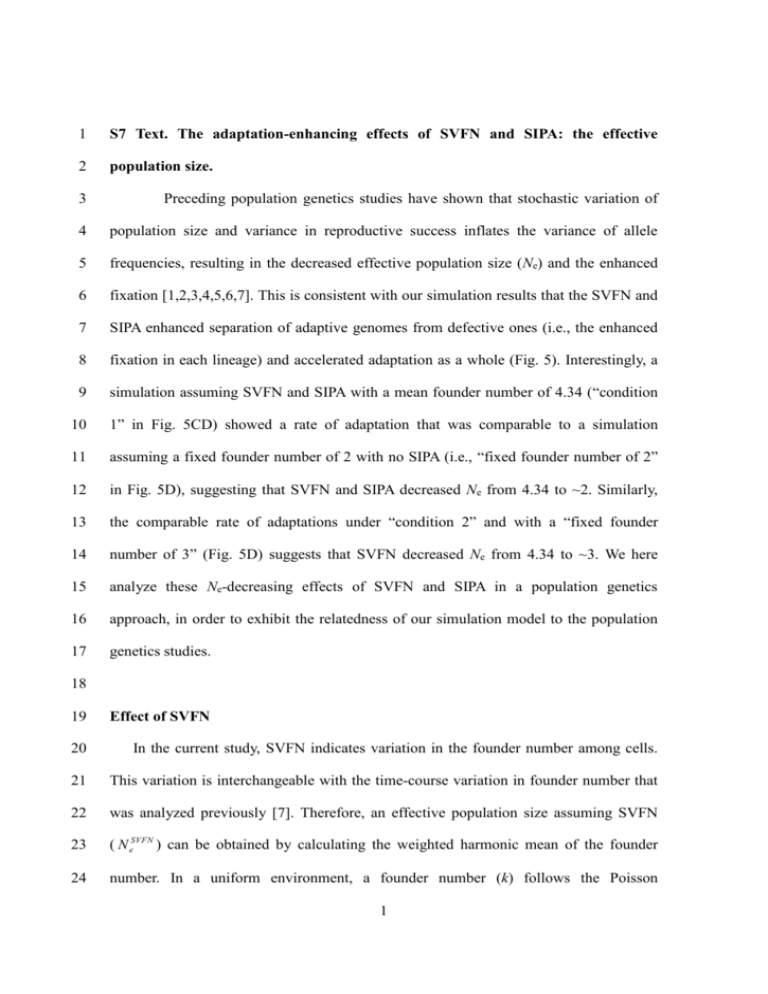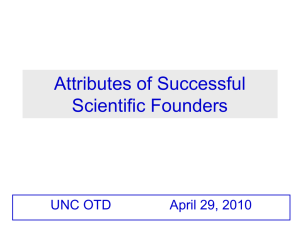S7 Text. The adaptation-enhancing effects of SVFN and SIPA: the
advertisement

1 S7 Text. The adaptation-enhancing effects of SVFN and SIPA: the effective 2 population size. 3 Preceding population genetics studies have shown that stochastic variation of 4 population size and variance in reproductive success inflates the variance of allele 5 frequencies, resulting in the decreased effective population size (Ne) and the enhanced 6 fixation [1,2,3,4,5,6,7]. This is consistent with our simulation results that the SVFN and 7 SIPA enhanced separation of adaptive genomes from defective ones (i.e., the enhanced 8 fixation in each lineage) and accelerated adaptation as a whole (Fig. 5). Interestingly, a 9 simulation assuming SVFN and SIPA with a mean founder number of 4.34 (“condition 10 1” in Fig. 5CD) showed a rate of adaptation that was comparable to a simulation 11 assuming a fixed founder number of 2 with no SIPA (i.e., “fixed founder number of 2” 12 in Fig. 5D), suggesting that SVFN and SIPA decreased Ne from 4.34 to ~2. Similarly, 13 the comparable rate of adaptations under “condition 2” and with a “fixed founder 14 number of 3” (Fig. 5D) suggests that SVFN decreased Ne from 4.34 to ~3. We here 15 analyze these Ne-decreasing effects of SVFN and SIPA in a population genetics 16 approach, in order to exhibit the relatedness of our simulation model to the population 17 genetics studies. 18 19 Effect of SVFN 20 In the current study, SVFN indicates variation in the founder number among cells. 21 This variation is interchangeable with the time-course variation in founder number that 22 was analyzed previously [7]. Therefore, an effective population size assuming SVFN 23 ( N eSVFN ) can be obtained by calculating the weighted harmonic mean of the founder 24 number. In a uniform environment, a founder number (k) follows the Poisson 1 25 distribution. We exclude infections by zero founders by calculating N eSVFN as follows: 26 27 Ne SVFN 1 . rk k 1 k Here, the relative frequency of k founder rk is 28 1 k e , rk k! 1 e 29 where λ is the mean founder number, including infection by zero founders. Using λ = 30 4.34, N eSVFN = 3.31, which is consistent with the simulation results. 31 32 Effects of SIPA at Different Founder Numbers 33 In the current study, SIPA defines the phenomenon whereby a different amount of 34 progenies accumulate in a cell from each single founder genome. First, we assumed that 35 two founders have alleles A and B at an overall ratio of p:(1 – p). A small founder 36 number causes variation in the ratio of the A allele in founders (pc) among cells, and 37 SIPA causes further variation in the ratio of the A allele in their progenies ( pcSIPA ). 38 Therefore, the overall variation after cell infections can be expressed as 39 V pcSIPA E pcSIPA p E p 2 SIPA c pc E p 2 p . (S1) 2 c 40 Assuming that SIPA follows beta distribution beta(α,β) with shape parameters α and β, 41 Equation S1 can be modified as follows: 42 43 V p cSIPA E p c 1 p c V pc 1 p p 2 V pc V pc 1 2 44 45 p1 p 1 V pc 1 1 1 p1 p p1 p 1 1 1 1 2 46 p1 p 1 1 2 1 47 Therefore, the effective population size (assuming that SIPA occurs) with a founder 48 number k = 2 ( N eSIPA2 ) is obtained using N eSIPA 2 49 2 1 1 . (S2) 1 50 By generalizing the beta distribution to the Dirichlet distribution Dir(α1, …, αk) with the 51 concentration parameters α1, …, αk, calculation of the effective population size for k 52 founders is possible. Considering that each founder begins replication from a single 53 genome molecule, the concentration parameters should be equal among the founders. 54 Defining the concentration parameter as α(k) α1 … = αk, Equation S2 is generalized as 55 N eSIPAk 1 k k 1 k 1 i k . k 1 1 k k 1 (S3) i 1 56 We estimated α(k) for each founder number k based on the simulated accumulation levels 57 summarized in Figure 3D using the maximum likelihood method. The estimates of α(k) 58 ( ̂ k ) are summarized in S4 Table. Subsequently, N eSIPAk was calculated using 59 Equation S3 and is summarized in S4 Table. The Ne-decreasing effects at different 60 founder numbers were calculated by N eSIPAk and are also shown in S4 Table. k 3 61 62 Combined Effects of SVFN and SIPA 63 The effective population size assuming both SVFN and SIPA ( N eSVFN& SIPA ) can be 64 obtained by calculating the weighted harmonic mean of N eSIPAk based on S4 Table. The 65 calculated N eSVFN& SIPA was 2.35, consistent with the simulation results. 66 67 References 68 1. Felsenstein J (1971) Inbreeding and variance effective numbers in populations with 69 70 71 72 73 74 75 76 77 overlapping generations. Genetics 68: 581-597. 2. Kimura M, Crow JF (1963) Measurement of effective population number. Evolution 17: 279-288. 3. Kimura M, Ohta T (1969) Average number of generations until fixation of a mutant gene in a finite population. Genetics 61: 763-771. 4. Nei M, Tajima F (1981) Genetic drift and estimation of effective population size. Genetics 98: 625-640. 5. Waples RS (1989) A generalized approach for estimating effective population size from temporal changes in allele frequency. Genetics 121: 379-391. 78 6. Wright S (1931) Evolution in Mendelian populations. Genetics 16: 97-159. 79 7. Wright S (1938) Size of population and breeding structure in relation to evolution. 80 Science 87: 430-431. 81 4






